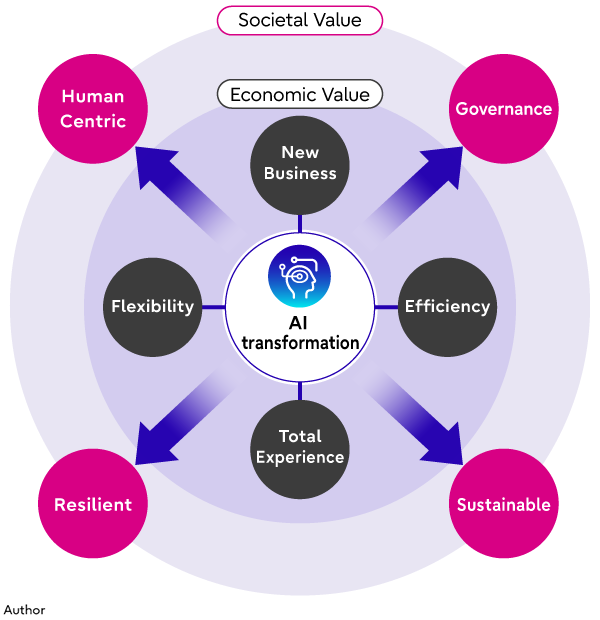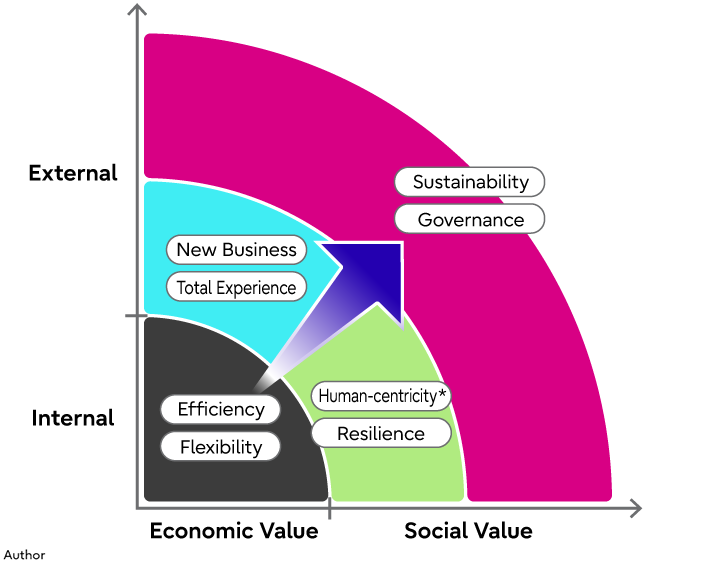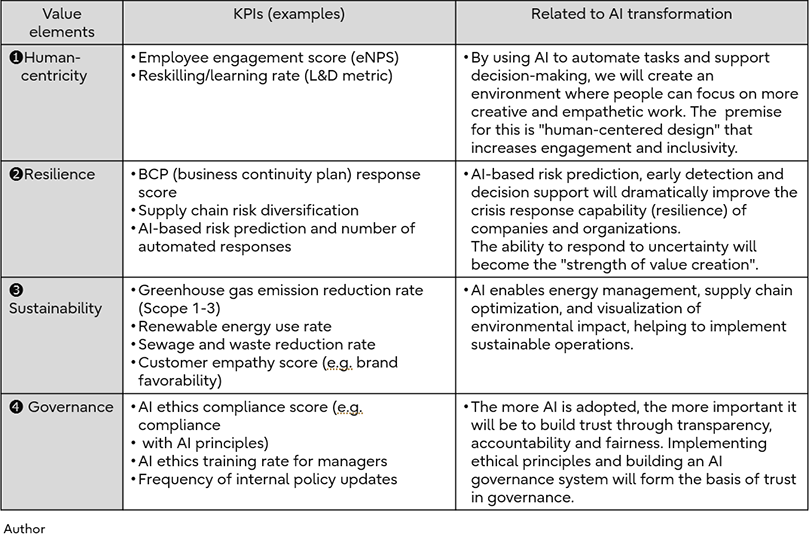Creating a Virtuous Cycle of Transformation and Trust: A Future Strategy Powered by AI and Net Positive Thinking

Article | 2025-6-5
15 minute read
How should we respond to the rapid rise of AI? As technology evolves, are businesses truly earning trust? In a time of accelerating change—driven by AI, decarbonization, and growing demands for social responsibility—the core challenge for companies is clear: how to balance economic performance with societal value.
Yet "net positive" management is still often viewed as an idealistic concept, and hesitation around AI adoption persists. The real question now is how to harness the transformative power of AI to create social value—and how to generate a "virtuous cycle of trust" as a result.
This paper presents three practical perspectives for companies aiming to realize such a cycle. These serve as a starting point for transforming ideals into actionable strategies—toward a model of sustainable and trusted management fit for the age of AI.
1. Introduction – The Dual Imperative Facing Corporate Management
Today’s business leaders are facing a level of complexity unlike anything they've experienced before. In addition to advancing sustainability initiatives such as climate action and decarbonization, companies must now navigate unpredictable disruptions—from geopolitical tensions to global pandemics. In the years ahead, business success is likely to be measured not only by financial outcomes, but increasingly by how companies contribute positively to society and the environment.
On one hand, technological innovations—most notably artificial intelligence (AI)—are driving heightened expectations for economic gains through improved operational efficiency, new value creation, and enhanced competitive advantage in the market.
What is drawing increasing attention is not merely the introduction of AI as a tool, but the broader AI Transformation*1—an enterprise-wide shift that redefines corporate strategy, organizational structure, workforce capabilities, and data utilization.
Among these developments, the rise of generative AI, which can produce natural-sounding text and respond to complex questions, has emerged as a top priority for companies across industries and sizes.
More recently, AI has begun evolving beyond passive assistants to become autonomous AI agents capable of executing tasks independently. As a result, AI transformation is becoming central to corporate strategy, rather than just a technological initiative.
At the same time, the rapid advancement of AI has brought with it new challenges, including privacy concerns, job displacement, and a lack of accountability. These issues are not merely externalities—they represent critical responsibilities and risks that companies must confront head-on*2.
To fully realize the potential of AI, it is essential to secure ethical integrity, public trust, and a Social License to Operate (SLO).
In this context, increasing attention is being paid to a new approach to sustainable business- Net Positive Business.
This concept goes beyond minimizing negative impacts. It seeks to actively create positive value for society and the environment, offering a more strategic and forward-looking framework than traditional compliance or corporate social responsibility (CSR) efforts.
That said, Net Positive Business is still often perceived at the operational level as abstract or idealistic. Concerns persist that it entails “additional costs” or conflicts with economic rationality, making it difficult to integrate into everyday business practice.
This paper proposes a different perspective: the pursuit of economic value through AI and social value through Net Positive Business should not be viewed as conflicting goals. Instead, they should be approached as an integrated management strategy.
By reframing this dual imperative, we aim to explore a new path for sustainable, competitive corporate leadership.
*1 "AI transformation" refers to the structural change across the organization triggered by the adoption of AI technology, such as redesigning business processes, reviewing organizational structure, improving decision-making and reshaping HR strategies.
*2 Naomi Hadatsuki, et al. (December 2023) “AI Trust and Fujitsu's AI Trust Technologies in Conversational Generative AI”
2. Rethinking the Divide — Economic vs. Social Value?
For many years, the performance of business management was primarily measured by its ability to generate economic value—increasing operational efficiency, enhancing agility, creating new revenue streams, and delivering seamless customer experiences. These were the defining drivers of competitive advantage.
However, the scope of value expected from businesses is expanding rapidly in response to global environmental changes and rising societal expectations (See Figure 1). Increasingly, stakeholders are calling for social value—in the form of enhanced resilience, human-centered work practices, sustainability, and transparent governance. As a result, companies are being asked to redefine what value creation truly means in this new era.

The False Trade-off Between Economic and Social Value
Traditionally, economic and social values have often been viewed as mutually exclusive. Many business leaders have hesitated to pursue social impact initiatives, fearing they might undermine financial performance. But that premise is becoming obsolete. In fact, creating social value is emerging as a key source of long-term competitive advantage.
Stakeholder capitalism, the growing dominance of ESG-driven investment, and regulatory calls for transparency are fundamentally reshaping corporate legitimacy. In this new context, social value is no longer a matter of external goodwill—it is a core driver of business continuity and stakeholder trust.
AI Transformation as a Lever for Integrated Value
The key enabler of this paradigm shift is AI Transformation—not merely the introduction of AI tools, but a fundamental rethinking of how organizations operate, from strategy and talent to data and decision-making.
AI transformation is not only a driver of economic value; it can also serve as a lever for expanding social value. Consider the following examples:
・Resilience: Predictive AI enhances business continuity and risk management.
・Human-centricity: AI-powered employee support systems improve well-being and enable flexible, inclusive work environments.
・Sustainability: AI enables real-time monitoring of supply chains and environmental impact.
・Governance: Ensuring transparency and accountability in AI-driven decision-making.
3. An Integrated Strategy for AI Transformation and Net Positive Management
Traditionally, "AI transformation" and "net positive business" were discussed separately. However, that approach is becoming outdated. Today, companies are integrating both strategies to maximize synergies (see Table 1).

The key advantage of this integration is that both can operate simultaneously on the same AI infrastructure and data foundation. This allows companies to advance their net positive strategy with minimal additional investment, leveraging existing AI infrastructure and data platforms to create new applications that generate social value.
Specifically, by reusing systems, tools, and data platforms already invested in for AI transformation, companies can balance both economic and social value. There’s no need to build new infrastructure from scratch—existing investments can be effectively utilized to achieve both goals.
Moreover, driving social value through these efforts can accelerate AI adoption, leading to additional economic returns. In short, net positive business is a highly strategic extension of AI investment, offering both economic and societal benefits.
From Trade-offs to Integration: The Strategic Value Arc
To better visualize this transformation, we propose a two-dimensional value map (See Figure 2). The horizontal axis represents the shift from economic to social value, while the vertical axis moves from internal (operations, employees) to external (markets, society) focus.

We define the transition from the bottom-left quadrant to the top-right as the Strategic Arc of Integrated Value—a journey from traditional performance metrics to a holistic view of long-term value. In other words, companies must start from the premise of conventional economic rationality, redesign their relationships with people, organizations and society, and ultimately become part of an ecosystem that continuously generates “integrated value”.
4. Transition to AI Transformation × Net Positive Management: Three Practical Recommendations for Executives
The integration of Net Positive Management and AI Transformation is no longer just an ideal but should be restructured as the core of corporate strategy. Building on the misunderstandings and structural challenges discussed in each of the above sections, as well as the concept of integrated value strategy, this section presents three actionable recommendations for executives.
Recommendation 1|Redefining Corporate Strategy: Updating Value Objectives and Advancing AI Transformation in the Intelligent Era
Today’s businesses are expected to go beyond economic efficiency and deliver broader value—including environmental sustainability and social impact. Value creation is no longer just about economic outcomes; it now calls for a more integrated approach that embraces economic, environmental, and societal value.
To respond effectively, companies must revisit and elevate their core value objectives. As shown in Figure 2, this journey reflects a shift from conventional economic goals toward a more holistic fusion with social priorities—a progressive evolution in how value is defined.
At the same time, rapid advances in AI have ushered in a new "intelligent era." From a management perspective, AI enables greater visibility into operations and allows companies to measure and optimize their impacts, interactions, and outcomes. In this context, realizing integrated value objectives will require companies to move beyond traditional AI usage—and evolve their plans into true AI transformation strategies.
Recommendation 2|Evolving Metrics: Integrating “Economic ROI” with “Net Positive ROI” through Unified KPIs
From a management standpoint, the integrated value discussed in Recommendation 1 must go beyond vision statements—it must be measurable. To make this possible, companies need to design unified KPIs that combine traditional economic ROI with a newly defined “Net Positive ROI” that captures multidimensional, non-financial performance.
Net Positive ROI includes metrics related to human capital, brand trust, and social impact. By integrating these with economic ROI and visualizing value through both quantitative and qualitative indicators, companies can enhance the precision and transparency of strategic decision-making.
While traditional KPIs—such as revenue, profit margin, and ROE—have long provided financial clarity, the four components of social value introduced in Section 3—human centricity, resilience, sustainability, and governance—are becoming new sources of value creation in the intelligent era.
Turning these non-financial dimensions into measurable KPIs will not only strengthen the credibility of Net Positive ROI but also elevate how corporate value is understood and assessed (see Table 2).

Recommendation 3 | Architecture Development: Building an AI Foundation that Simultaneously Delivers Economic and Social Value
As outlined in Section 3, a key strength of the integrated strategy proposed in this paper is its ability to reframe the relationship between economic and social value—not as a trade-off, but as mutually achievable outcomes through the strategic use of digital platforms, particularly AI.
By developing a company-wide value creation architecture—centered around cloud services, AI models, and data infrastructure such as data lakes, data warehouses (DWH), and retrieval-augmented generation (RAG)—organizations can establish a shared digital foundation that supports both AI transformation and net positive business practices (see Figure 3). This architecture allows companies to streamline their investments, focusing primarily on applications essential for delivering and measuring social value, thus achieving greater cost efficiency.

Moreover, the creation of social value serves as a catalyst for accelerating AI adoption, which in turn amplifies economic returns. This virtuous cycle enhances both the bottom line (productivity gains) and the top line (revenue growth), ultimately positioning the company to secure a sustainable source of competitive advantage over the long term.
Conclusion | Transitioning Toward a New Management Paradigm
These recommendations are not simply aspirational—they reflect a pragmatic path shaped by the convergence of technology and evolving societal expectations.
What leaders may need most today is the quiet discipline to ask themselves:
“Is our organization truly a net positive force in society?”
Companies that endure into the future will be those with the foresight—and the courage—to continually engage with this question, rather than turn away from it.
Dr. Jianmin Jin (Ph.D in International Economic Law)
Chief Digital Economist Fujitsu Ltd.
Senior Director
Global Marketing Unit
2020 Fujitsu Ltd., Chief Digital Economist. 1998 Fujitsu Research Institute, Senior Fellow.
Dr. Jin's research mainly focuses on global economic, digital innovation/digital transformation, and Dr. Jin has published books such as ”Towards the Creation of a Japan’s Silicon Valley”(2020), etc.

Are you Net Positive ready?
Discover how your organization is advancing toward a thriving, Net Positive future.


